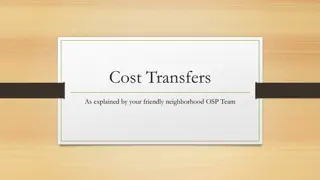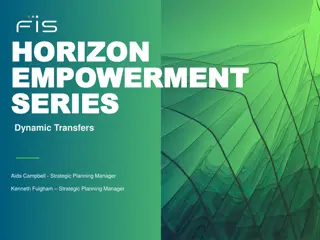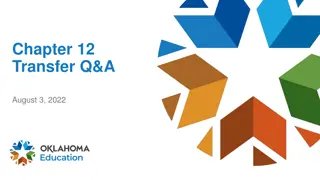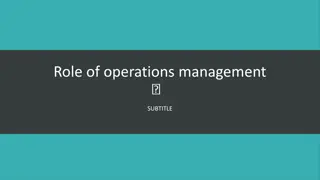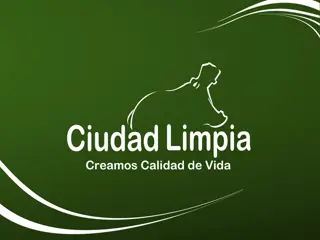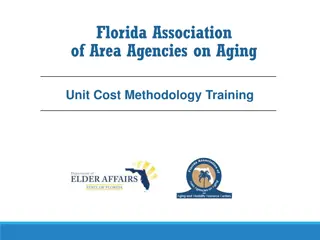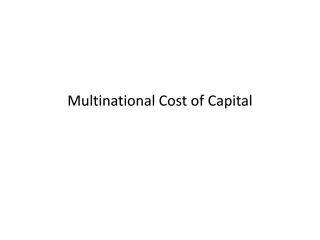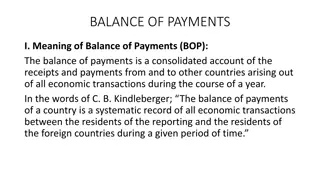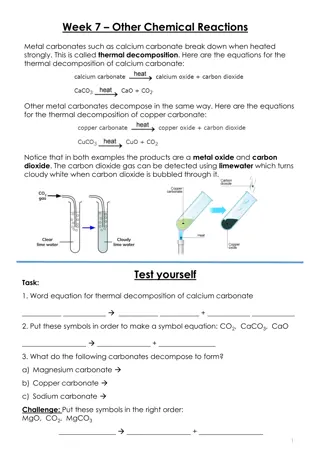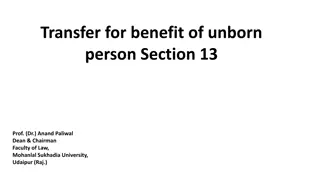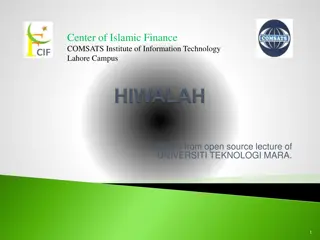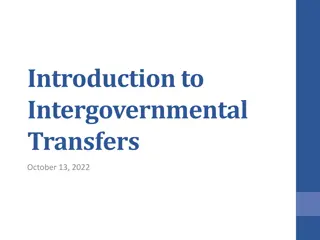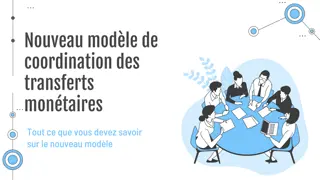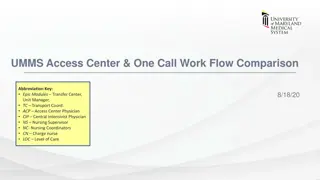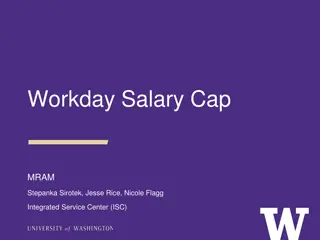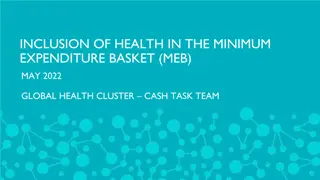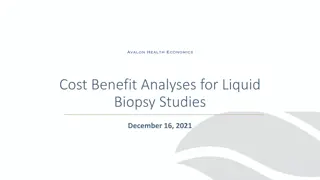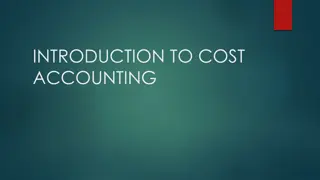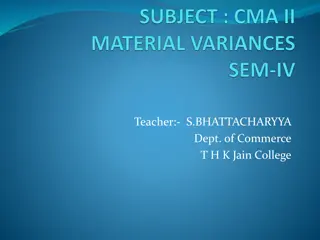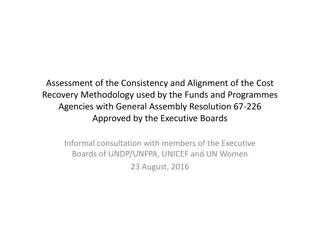Understanding Cost Transfers in Research Operations Training
This training session covers various aspects of cost transfers in research operations, including different types, executing salary transfers, inter-program transfers, reimbursements, toxic exposure fund requirements, and financial updates for FY 23. Participants will gain insights into when and how to transfer costs between different programs and appropriations, collect reimbursements, and understand key financial requirements. The session is designed to enhance the understanding of cost transfers in research settings.
Download Presentation

Please find below an Image/Link to download the presentation.
The content on the website is provided AS IS for your information and personal use only. It may not be sold, licensed, or shared on other websites without obtaining consent from the author. Download presentation by click this link. If you encounter any issues during the download, it is possible that the publisher has removed the file from their server.
E N D
Presentation Transcript
Expenditure Transfers in Research June 28, 2023 John Verwiel, Deputy Director, Finance Jason Berlow, Management Analyst, Finance Erin Olson, Budget Analyst, ORD Finance Kari Points, Director Research Operations Iowa City Diane Murphy, Budget Analyst, ORD Finance Tony Laracuente, Director of Field Operations 1
Housekeeping Notes Housekeeping Notes Webinar Webinar Housekeeping Housekeeping Q&A - Please use the Q&A feature to submit questions. Be sure to send questions to All panelists . Questions will be addressed at the end of the webinar. Recording - This session is being recorded and the associated handouts will be available on ORPP&E s Education and Training website within one-week post-webinar. Webinar Archive - Most ORPP&E webinars can be found here: https://www.research.va.gov/programs/orppe/educati on/webinars/archives.cfm Close Captioning - Now available in the new Webex platform. Click the CC button at the bottom left of the Webex screen. Post-Webinar Evaluation Survey - We are grateful to all that complete the post-webinar evaluation survey. It will automatically pop up once the webinar is exited. Experiencing Sound Issues? Call in using the number in your Webex chat box or in your registration confirmation email. For questions, please use Q&A box and address to All Panelists. All Webinars will be recorded and posted within one week.
Objectives for Todays Training Objectives for Today s Training Training Section: By the end of this section, you will: Section 1: Introductory Concepts Understand the basic framework of cost transfers vs IAAs Understand the different types of cost transfers Understand cost transfers are movement of costs and not ceiling transfers Section 2: Current Year to Prior Year Understand when to execute Current Year to Prior Year salary cost transfers Understand what information is necessary to provide Fiscal Section 3: Inter-Program Transfers Understand when and how to transfer costs between Research programs for staff that work on more than one research project Section 4: To/From Medical Center Understand when and how to transfer costs between a Research Appropriation and the Medical Center Appropriation Section 5: Reimbursements Understand how to collect reimbursements from NPCs, Universities, and other Federal agencies to cover costs Section 6: Toxic Exposure Fund Understand the specific requirements for the Toxic Exposure Fund and Expense Transfers Section 7: FY 23 Execution Update/Finance Resource Sharepoint A review of the key financial requirements for the end of FY 23. Understand where to find answers to your questions on the Finance Resource Sharepoint Q&A 7/10/2024 3
Section 1: Introductory Concepts Section 1: Introductory Concepts What is the policy on Expense/Cost Transfers? 4
Section 1: What are the VAs Policies regarding expenditure transfers? Section 1: What are the VA s Policies regarding expenditure transfers? Expenditure transfers are authorized by: 31 U.S. Code 1534 - Adjustments between appropriations The reference can be located in the GAO Red Book (Chapter 2, Legal Framework, Page 2-41): Under the account adjustment statute, an agency may temporarily charge one appropriation for an expenditure benefiting another appropriation of the same agency, as long as amounts are available in both appropriations and the accounts are adjusted to reimburse the appropriation initially charged during or as of the close of the same fiscal year. 31 U.S.C. 1534. This statute facilitates common service activities. The VA Financial Policy Manual, Volume I, Chapter 9, Expenditure Transfers details the VA wide guidance on expenditure transfers. In general, expenditure transfers are used when: Goods and services are ordered between Agencies Specific law mandates a payment between appropriations The payment is between Federal and Trust Funds Payment is recorded in one appropriation and adjustment is needed to record properly 1. VA Financial Policies and Procedures: Volume I Chapter 9 (2012) 5
Section 1: What are Cost Transfers & Why Do We Do Them Section 1: What are Cost Transfers & Why Do We Do Them Cost (expenditure) transfers move the cost already incurred from one control point to another. They can be executed across programs, fiscal years or appropriations Majority of cost transfers involve salary expenses; however, Cost transfers can also be processed for purchases or services from all other Fund Control Points when that cost has already paid and closed. Note that clinical services (Laboratory, Pharmacy, Radiology) require Interagency Agreements (IAAs) - more on that later Dependent on your station you ll work with Fiscal (Budget and/or Accounting) 6
Section 1: What are Cost Transfers & Why Do We Do Them Section 1: What are Cost Transfers & Why Do We Do Them Why do we execute Cost Transfers? To properly cost an expense to the right FCP/Program/Appropriation Reduce prior year balances (close out prior year funds) Reimburse control points from X2 fund balances (transfer the costs from the FCP where they occurred to the reimbursable account to close the loop/offset the expense in the correct appropriation) Reimburse control points from R1 fund balances (transfer the costs from the FCP where they occurred to the reimbursable account to close the loop/offset the expense in the correct appropriation) Remember the R1 account expires 7
Section 1: What are Cost Transfers & Why Do We Do Them Section 1: What are Cost Transfers & Why Do We Do Them The difference between a ceiling transfer and a cost transfer: Ceiling transfer is moving funds from all other FCP to salary FCP within the same program (does not impact obligations) Cost transfer is transferring costs (an obligation that has already been expensed-so the payroll has hit, or the vendor has been paid) to the correct fund control point, program, or appropriation 8
Section 1: When is a Cost Transfer executed vs an IAA Section 1: When is a Cost Transfer executed vs an IAA IAA Cost Transfer Represents a buy/sell transaction between two federal entities where goods or services are purchased by one entity from another entity (see VA Financial Policy Manual Volume 1-Chapter 11a). Purchasing a service or supplies from another department at your VAMC, such as pharmacy, MRI, X-Ray or laboratory tests. Other federal agencies Interagency Agreements (see IAA Training). Represents a transfer of expenditure (in accordance with (Volume I, Chapter 9, Expenditure Transfers) Splitting Salary Cost between Research and Clinical should be done by cost transfers and NOT an IAA/G-Invoicing. Cost transfers are the appropriate method when salary is involved for employees that would otherwise be split in appropriations and no tangible services are involved. VHA Finance and FSC have instructed ORD that this activity does not represent an exchange of supplies or services (buy/sell transaction) which would require an IAA. 9
Section 1: The Different Types of Cost Transfers Section 1: The Different Types of Cost Transfers In this presentation we will outline 5 different types of cost transfers, outlined below: Type Purpose Transfer Occurs Current Year to Past Year Objective is to clear out prior year funds as quickly as possible Typically used for salaries When closing out the prior year Anytime there is a balance that occurs in prior year (example: deobligation of prior year order) Research Program to Research Program Used when there are costs that occur in two programs but there is only one transaction for that item Quarterly (if not more often), as costs occur in the Current Year Research Appropriation to/from a Medical Center Used when there are costs that are shared between the Medical Center Appropriation and the Research Appropriation Typically occur for salary costs, but can also be utilized when sharing cost of a purchase order Quarterly (if not more often), as costs occur in the Current Year Reimbursements Handle reimbursements from Research Non-Profit Corporations (NPCs), non-Federal Institutions (Universities), and Interagency agreements (with Federal agencies) Throughout the year (as reimbursements come in) Quarterly, 10th business day of month after end of quarter. Toxic Exposure Fund (TEF) TEF costs for personnel will need to be first paid out of the Research appropriation because personnel can only be funded out of one Fund Control Point (FCP). Due to this accounting/HR Smart structure, Research Offices and Facility Fiscal/Accounting Office will collaborate and coordinate to perform expenditure transfers every quarter (per our guidance on the Toxic Exposure Fund). 10
Section 2: Current Year to Prior Year Cost Transfers Section 2: Current Year to Prior Year Cost Transfers It is CRUCIAL to ensure that prior year funds are executed by the deadlines set by ORD. Limit the amount of carry-over to 2% and ensure you have the salary expenses to conduct the cost transfers by January 15th for the remaining 2% amount (or less). Carryover at each individual station results in large balances, ripe for recission. ORD and VHA must make the case to OMB and Congress to provide additional funds for research and these messages are undercut when we do not execute the funds we do have. 11
Section 2: Overview of Current Year to Prior Year Transfers Section 2: Overview of Current Year to Prior Year Transfers Goal is to have prior year funds to $0 by January 15th each year Should be completed anytime an obligation with a balance is closed or modified and funds are returned to a prior year fund control point (FCP) This can happen at any time during the fiscal year and should be monitored closely Basic Steps: Move the Ceilings Create the Request Email Fiscal Confirm the Cost Transfer has been Completed 12
Section 2: Moving the Ceilings Section 2: Moving the Ceilings Utilize the Status of Allowance (SOA) FMS Unob column to determine the funds remaining in each prior year FCP If funds remain in an All Other (supply) FCP, request a movement of ceilings to move funds from the All Other FCP to the salary FCP within the same research program Ensure that there are no pending IFCAP transactions prior to the ceiling move If there is IFCAP pending, leave enough funds in the All Other FCP to cover those costs and work to close out the pending items Request the ceiling transfer for the amount not needed to cover the pending transactions Once the IFCAP pending is closed out, repeat these steps to complete a final close out of the FCP 13
Section 2: Moving the Ceilings (Example) Section 2: Moving the Ceilings (Example) In the SOA below, there is $91,830.56 in the All Other FCP for Program 81. A request needs to be made to move that dollar amount from the budget (ceilings) column to the salary FCP. Here is what that request should look like: 14
Section 2: Moving the Ceilings (Example) Section 2: Moving the Ceilings (Example) In the SOA below, there is $91,830.56 in the All Other FCP for Program 81. A request needs to be made to move that dollar amount from the budget (ceilings) column to the salary FCP. Here is what that request should look like: 15
Section 2: Creating the Request Section 2: Creating the Request Before you can request the cost transfer, you need to identify the salaries that will be part of the request. If you do not use WinRMS: You will need to be tracking the PAID reports that you receive from Fiscal from each Pay Period to request the cost transfer. If you use WinRMS: Go to Reports -> Employee-Salary Reports -> Click on Excel instead of PDF-> Current Pay Period Report -> Select the Pay Period used You may need more than one pay period to complete the cost transfer depending on the dollar amount. Note: Make sure you select a pay period that you have not previously done a cost transfer for during the year. Calculate the salaries until you have the amount needed to complete the cost transfer. To total the exact amount of the cost transfer needed, you will most likely count a partial amount of salary for one individual 16
Section 2: Send Request to Fiscal Section 2: Send Request to Fiscal Fiscal, Please perform the following cost transfer(s) listed below. The attached spreadsheet indicates the salary, pay periods, and hours that make-up this request. Transfer costs from FCP 403 23/24 to FCP 403 22/23 in the amount of $95,418.57. Make sure you close the loop. Check the SOA once fiscal notifies you the cost transfer has processed. 17
Section 3: When to Use Inter Section 3: When to Use Inter- -Program Transfers Program Transfers Conducted within the 0161A1 appropriation and may be completed in both salary and all other FCPs. Used when there are costs that occur in two programs but there is only one transaction for that item. A justification must be included to move costs between programs. The Programs in the 0161A1 appropriation include: Program 81: Biomedical Laboratory Research and Development (BLR&D) Program 82: Rehabilitation Research and Development (RR&D) Program 84: Health Services Research and Development (HSR&D) Program 85: Clinical Science Research and Development (CSR&D) Program 86: Million Veteran Program (MVP) 18
Section 3: Example of Salary Cost Transfer Section 3: Example of Salary Cost Transfer Mickey Mouse is working on an HSR&D (Program 84) project at 75% effort and on a CSR&D (Program 85) project at 25%. Most of his effort is HSR&D, so his salary is applied to that FCP. Since you can only apply salary to one FCP, a cost transfer is needed to charge the remaining 25% to CSR&D. Reoccurring salary cost transfers should be completed at a minimum of quarterly. Track the salary for the individual(s) by pay period so that you can routinely request the cost transfer from Fiscal. For Q1 of this example: Fiscal, Please complete the following cost transfer for Quarter 1 expenses. This is for 25% salary that needs to be transferred to the CSR&D program for his work on a project. The amount of costs that needs to be transferred from FCP 414 23/24 (HSR&D, Program 84) to FCP 417 23/24 (CSR&D, Program 85) is $8044.79. 19
Section 3: All Other FCP Cost Transfers Section 3: All Other FCP Cost Transfers An All Other cost transfer used for obligations under one Research Program that shares expenses with another Research Program. For example, a contract was set-up for a core facility at your affiliate and charged to the BLR&D All Other FCP. However, there are investigators in RR&D that also utilize that core facility. As you receive invoices for that core facility in IPPS, determine the charges that were made to RR&D investigators and request a cost transfer from Fiscal for those charges. Example: Fiscal, Please request a cost transfer from FCP 4663 23/24 (BLR&D, Program 81) to FCP 4667 23/24 (RR&D, Program 82) in the amount of $XX. RR&D investigators utilized PO # which is the contract for core facility services at the University. BLR&D needs to be reimbursed for these expenses. The attached invoices describe this usage. 20
Section 4: Transfers Between 0161A1 and Medical Center Section 4: Transfers Between 0161A1 and Medical Center It is best practice to place individuals within the appropriation where they are conducting most of their work and establish a Memorandum of Understanding Reoccurring salary cost transfers should be completed at a minimum of quarterly, if not more often. You will need to track the salary for the individual(s) by pay period so that you can routinely request the cost transfer from Fiscal. In the example of the individual that is working 75% for Medical Center and 25% for Research, the request would look like: Fiscal, Please complete the following cost transfer for Quarter 1 expenses. This is for 25% salary that needs to be transferred from the Medical Center Appropriation to the Research Appropriation for her work on a project. The amount of costs that needs to be transferred from FCP 482 (0160A1) to FCP 417 23/24 (0161A1, CSR&D, Program 85) is $3623.10. The attached Memorandum of Understanding justifies this transfer. 21
Section 4: Sample Memorandum of Understanding Section 4: Sample Memorandum of Understanding 22
Section 4: All Other FCP Cost Transfers Section 4: All Other FCP Cost Transfers Establish an agreement between the Medical Center and the Research department regarding the percentage of cost for each appropriation Typically, the appropriation carrying most of the cost would issue the purchase order under their FCP. If the cost is split in half, an agreement needs to be made Once invoiced, a cost transfer should be requested to transfer expenses from the appropriation that made the purchase to the other appropriation For example, a piece of equipment is being purchased that will be utilized 75% by the Medical Center and 25% by Research personnel. Each agree to pay for their percentage of the equipment. The Medical Center will purchase the equipment under a Medical Center FCP. Once invoiced, they will request that 25% of the cost be transferred to a Research All Other FCP. 23
Section 5: Reimbursements Section 5: Reimbursements 24
Section 5: Reimbursement Step by Step Section 5: Reimbursement Step by Step Link to Reimbursables Training First step is to set-up Reimbursable FCPs to handle reimbursements: Research Non-Profit Corporations (NPCs) sent as 0161X2 funds Non-Federal Institutions (Universities) sent as 0161R1 funds Interagency agreements (with Federal agencies) sent as 0161R1 funds Once the reimbursements are sent via TDA and deposited into the appropriate reimbursable FCP, a cost transfer needs to be done as the final step in the reimbursement process. This needs to be completed throughout the year as reimbursements come in 25
Section 5: As Reimbursements are Received Section 5: As Reimbursements are Received Four-Step Process for Completing the Cost Transfer 1. After you receive the TDA for reimbursements, you need to identify the bills of collections that you received the reimbursements for. To do this, contact your Fiscal Office and ask for the monthly F827 General Ledger Report. This will provide the billing numbers for the reimbursements 2. In looking up the bill number, the items in the bill can be identified. This provides you with the information to complete the cost transfer. The cost transfer should be between where the original cost occurred and the reimbursable FCP 3. Request the cost transfer from Fiscal 4. Always check to confirm that the Cost Transfer has been completed 26
Section 5: Reimbursement Example Section 5: Reimbursement Example 1) In this example, the F827 GL report showed the following for September 2022. The highlighted number is the Bill of Collection number from the VISTA bill. 2) In this example, the bill of collection K22CLIG was for salary. That individual is in FCP 403 22/23 (Program 81, BLR&D). 3) Email template to request Reimbursement Cost Transfer: Fiscal, Please transfer costs from FCP 403 22/23 (0161A1, Program 81 BLR&D) to FCP 4641 22/23 (0161R1) in the amount of $28,679.20. This is in reference to Bill of Collection #K22CLIG for Donald Duck s salary from 4/1/22-6/30/22. 27
Section 5: Always Check to Confirm Transfer was Completed Section 5: Always Check to Confirm Transfer was Completed Each time you request a cost transfer, you should confirm the Cost Transfer: Utilize the VSSC website = VSSC - VHA Support Service Center (va.gov) Go to the F20D-Daily Activity by Account Classification Code. Select the current FY, your VISN, and your Facility. Under the Select Fund option, both the 0161A1 funds and either the 0161R1 or the 0161X2 need to be selected so you can see both sides of the transaction. Enter the date range for the cost transfer An EW number indicates that the cost transfer was complete. You will need to check the 0161A1and either the 0161R1 or 0161X2 FCPs in order to see both sides of the transaction 28
Section 6: Toxic Exposure Fund (TEF) Additional Requirements Section 6: Toxic Exposure Fund (TEF) Additional Requirements 7/10/2024 29
Section 6: Toxic Exposure Fund (TEF) Section 6: Toxic Exposure Fund (TEF) As a reminder, impacted stations received a memo/guidance if they received TEF funding, it can be found on the ORD Finance Resource Center. TEF costs for personnel will need to be first paid out of the Research appropriation because personnel can only be funded out of one Fund Control Point (FCP). Due to this accounting/HR Smart structure, Research Offices and Facility Fiscal/Accounting Office will collaborate and coordinate to perform expenditure transfers every quarter (per our guidance on the Toxic Exposure Fund). 30
Section 6: A Note About Toxic Exposure Funding Section 6: A Note About Toxic Exposure Funding If your station has Toxic Exposure Funding, familiarize yourself with the guidance here: ORD Field Finance Resource Center - ORD Guidance Toxic Exposure Fund 2.24.23_RR.pdf - All Documents (sharepoint.com) Toxic Exposure Fund cost transfers need to happen by the 10th business day following each quarter (for Q3 this is July 17th, 2023). 31
Section 6: TEF Reporting Section 6: TEF Reporting The Expense Transfer is critical to ensure that we can properly report TEF Obligations/Expenditures to Congress. We will review the F20 Report in VSSC to determine the status of station cost transfers (after the deadline). Deadline to Expense Transfer is July 17, 2023 32
Section 7: Budget Status and SharePoint Site Section 7: Budget Status and SharePoint Site 33
FY 2023 Budget Execution Activity Deadline Specifics CC 101 Data Call Due June 30, 2023 Data Call issued on 6/9/23, Go to: CC101 Data Call (office.com) RETURNING FUNDS IN NO WAY IMPACTS THE PROJECTED FY 24 ALLOCATION. Returned funds will be used to support projects and other high priority initiatives in FY 23 and help reduce the carryover amounts in the field. RAFT Execution Report and Excess Funding swept prior to close of FY 23 July 15, 2023 We will be looking at stations with balances prior to the end of FY 23 to determine if a plan is feasible to obligate 98% of current year funding by 9/30/23. We will then consider sweeping these funds for reprograming for other requirements for the Research enterprise. These funds will not be returned in FY 24. Stations were expected to review balances and provide PMOs by 3/30/2023 (as sent via email by the Director of Field Operations on 2/13/23). Enhanced Tracking Obligations Data call to occur in early 4th Quarter ORD Finance will issue a data call for open obligations in the 4th quarter of FY 23 to determine the status of obligations in prior year (22-23). 34
ORD Finance Resource Center ORD Finance Resource Center Link: ORD Field Administrative Officer and Financial Management Resources (sharepoint.com) 35
Questions? Questions? 36


